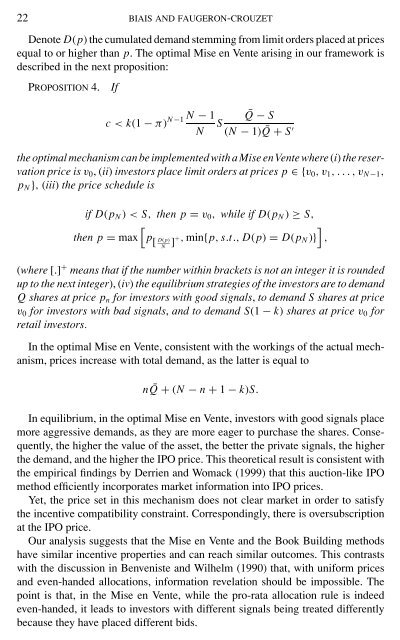IPO Auctions: English, Dutch, ... French, and Internet
IPO Auctions: English, Dutch, ... French, and Internet
IPO Auctions: English, Dutch, ... French, and Internet
You also want an ePaper? Increase the reach of your titles
YUMPU automatically turns print PDFs into web optimized ePapers that Google loves.
22 BIAIS AND FAUGERON-CROUZET<br />
Denote D(p) the cumulated dem<strong>and</strong> stemming from limit orders placed at prices<br />
equal to or higher than p. The optimal Mise en Vente arising in our framework is<br />
described in the next proposition:<br />
PROPOSITION 4. If<br />
N−1 N − 1<br />
c < k(1 − π)<br />
N S<br />
¯Q − S<br />
(N − 1) ¯Q + S ′<br />
the optimal mechanism can be implemented with a Mise en Vente where (i) the reservation<br />
price is v0,(ii) investors place limit orders at prices p ∈{v0,v1,...,vN−1,<br />
pN }, (iii) the price schedule is<br />
if D(pN ) < S, then p = v0, while if D(pN ) ≥ S,<br />
<br />
then p = max p D(p) [ N ] +, min{p, s.t., D(p) = D(pN<br />
<br />
)} ,<br />
(where [.] + means that if the number within brackets is not an integer it is rounded<br />
up to the next integer), (iv) the equilibrium strategies of the investors are to dem<strong>and</strong><br />
Q shares at price pn for investors with good signals, to dem<strong>and</strong> S shares at price<br />
v0 for investors with bad signals, <strong>and</strong> to dem<strong>and</strong> S(1 − k) shares at price v0 for<br />
retail investors.<br />
In the optimal Mise en Vente, consistent with the workings of the actual mechanism,<br />
prices increase with total dem<strong>and</strong>, as the latter is equal to<br />
n ¯Q + (N − n + 1 − k)S.<br />
In equilibrium, in the optimal Mise en Vente, investors with good signals place<br />
more aggressive dem<strong>and</strong>s, as they are more eager to purchase the shares. Consequently,<br />
the higher the value of the asset, the better the private signals, the higher<br />
the dem<strong>and</strong>, <strong>and</strong> the higher the <strong>IPO</strong> price. This theoretical result is consistent with<br />
the empirical findings by Derrien <strong>and</strong> Womack (1999) that this auction-like <strong>IPO</strong><br />
method efficiently incorporates market information into <strong>IPO</strong> prices.<br />
Yet, the price set in this mechanism does not clear market in order to satisfy<br />
the incentive compatibility constraint. Correspondingly, there is oversubscription<br />
at the <strong>IPO</strong> price.<br />
Our analysis suggests that the Mise en Vente <strong>and</strong> the Book Building methods<br />
have similar incentive properties <strong>and</strong> can reach similar outcomes. This contrasts<br />
with the discussion in Benveniste <strong>and</strong> Wilhelm (1990) that, with uniform prices<br />
<strong>and</strong> even-h<strong>and</strong>ed allocations, information revelation should be impossible. The<br />
point is that, in the Mise en Vente, while the pro-rata allocation rule is indeed<br />
even-h<strong>and</strong>ed, it leads to investors with different signals being treated differently<br />
because they have placed different bids.
















